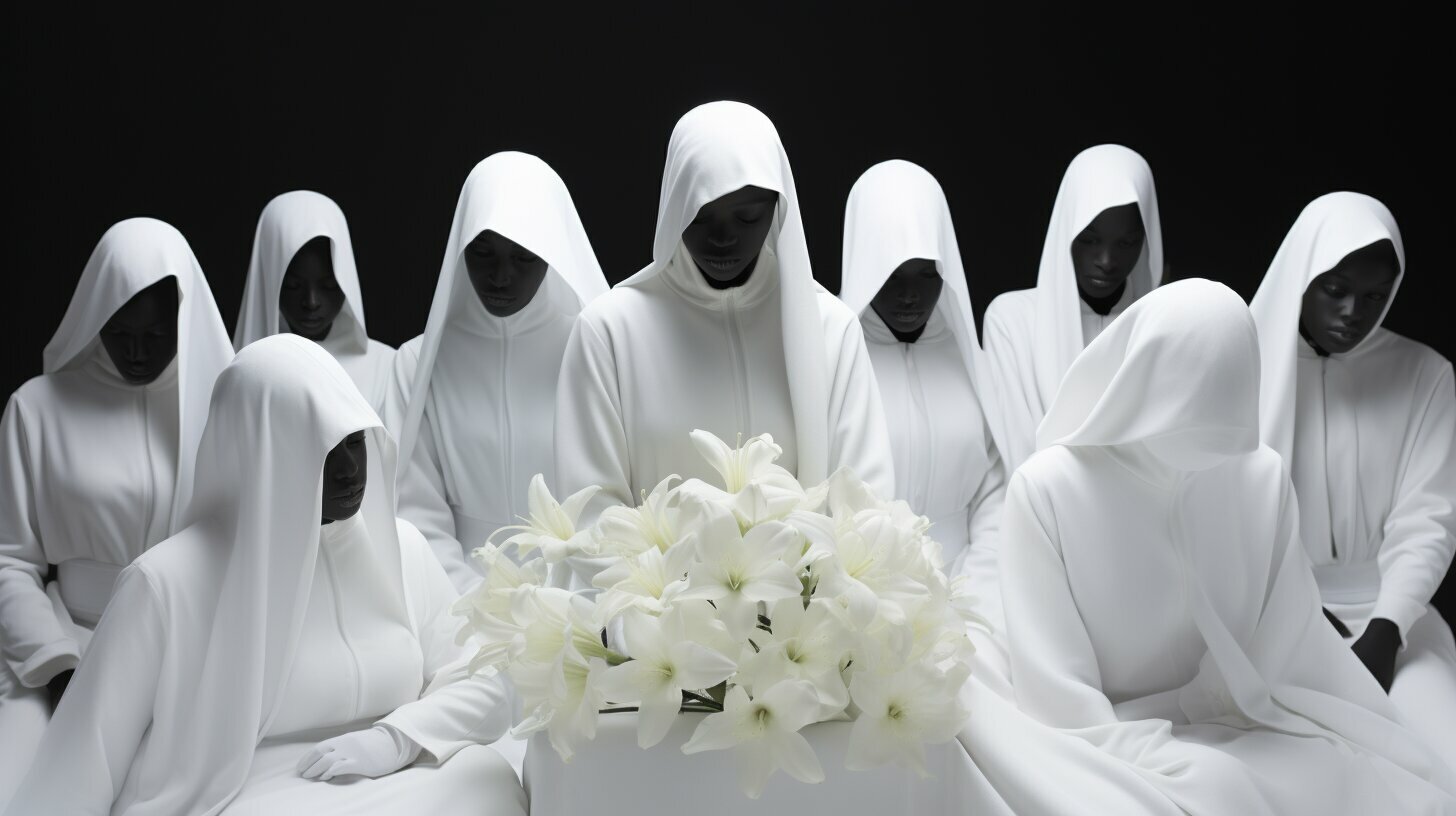Why Do People Wear White to Funerals? A How-to-Mourn Guide.
Funerals are a solemn occasion where we pay our final respects to the departed. But have you ever wondered why some people choose to wear white instead of the traditional black? In this how-to-mourn guide, we will explore the cultural reasons behind wearing white to funerals and shed light on this unique funeral attire.
Key Takeaways:
- Wearing white to funerals has a long history and is seen in mourning customs around the world.
- Black is the traditional color of mourning in Western culture, but white has also been used to symbolize loss, particularly for children and the unmarried.
- The roots of wearing white to funerals can be traced back to the early Christian church, where widows would dress in black, grey, and white to represent their loss of joy and rejection of a sexual lifestyle.
- In the Victorian era, mourning dress became more standardized and widespread, following the death of Queen Victoria’s husband, Prince Albert.
- When considering wearing white to a funeral, it is important to be mindful of the specific circumstances and cultural customs.
Now that we’ve set the stage, let’s dive into the history and symbolism of wearing white to funerals.
The History and Symbolism of Wearing White to Funerals
To understand why people wear white to funerals, we need to travel back in time and explore the rich history and symbolism associated with this color choice. Wearing white to mourn the loss of a loved one is not a recent trend but has deep roots in funeral customs and traditions around the world.
In Western culture, black is traditionally associated with mourning. However, white has also been used to symbolize loss, particularly for children and the unmarried. The origins of wearing white to funerals can be traced back to the early Christian church. Widows would dress in black, grey, and white to represent their loss of joy and rejection of a sexual lifestyle. White, which was associated with purity, humility, and chastity, was also reminiscent of the clothing worn by nuns.
Over time, mourning fashion evolved, and white was reintroduced into daily dress between the 17th and 19th centuries. The Victorian era, in particular, played a significant role in shaping mourning customs. After the death of Queen Victoria’s husband, Prince Albert, mourning dress became more standardized and widespread. Black became the dominant color of mourning, worn by both the aristocracy and the middle classes. Mourning attire was regulated by sumptuary laws, and the mourning industry thrived during this period.
While black continues to be the traditional color of mourning, there is more flexibility in funeral attire today. White can also be appropriate in certain circumstances. However, when considering wearing white to a funeral, it is important to be mindful of specific cultural customs and the wishes of the family. Wearing white may be seen as offensive in some cases, especially if you are a close family member of the deceased or if you do not offset the white with darker colors. The key is to show respect for the deceased and their loved ones, and to not draw attention to yourself during this solemn occasion.
The Influence of Early Christian Church and Victorian Era on Funeral Attire
The origins of wearing white to funerals can be traced back to the early Christian church and the Victorian era, where specific mourning customs influenced the color choices and attire worn during funerals. During these periods, white became associated with purity, chastity, and humility, making it a fitting color for mourning attire.
In the early Christian church, widows wore black, grey, and white to symbolize their loss of joy and rejection of a sexual lifestyle. White, similar to the clothing worn by nuns, represented purity and devotion. This tradition of wearing white as a sign of mourning was observed by widows who wanted to honor their deceased spouses and showcase their commitment to a life of celibacy and religious devotion.
The Victorian era further solidified the use of black and white as mourning colors. Following the death of Prince Albert, Queen Victoria popularized the practice of wearing black as a sign of mourning. It became the dominant color of mourning, worn not only by the aristocracy but also by the middle classes. Mourning dress regulations were introduced, governing the length of mourning periods and the appropriate attire for each stage of mourning.
| Early Christian Church | Victorian Era |
|---|---|
| Widows dressed in black, grey, and white | Queen Victoria popularized wearing black as a sign of mourning |
| White symbolized purity, chastity, and devotion | Mourning dress regulations were introduced |
While black remained the predominant color for mourning, white was reintroduced into daily dress between the 17th and 19th centuries. This shift in mourning fashion coincided with changing cultural attitudes towards death and mourning. White came to represent a softer form of mourning, particularly for children and the unmarried. It became acceptable to wear white at funerals, especially when offset with darker colors.
Today, funeral attire has evolved, and there is more flexibility in what is considered appropriate. While black is still the traditional color of mourning, wearing white can be acceptable in certain circumstances. It is essential to be mindful of the specific cultural customs and the wishes of the deceased’s family. Incorporating white into an otherwise conservative and tasteful outfit can be a respectful way to honor the deceased while adhering to funeral etiquette.
Summary:
- The early Christian church and the Victorian era influenced the color choices and attire worn during funerals.
- White was associated with purity, chastity, and devotion in the early Christian church, while black became the dominant color of mourning in the Victorian era.
- Mourning dress regulations were introduced during the Victorian era, governing the appropriate attire for each stage of mourning.
- White was reintroduced into daily dress between the 17th and 19th centuries, representing a softer form of mourning.
- Today, funeral attire has more flexibility, and wearing white can be acceptable in certain circumstances.
Modern Funeral Attire and Cultural Considerations
While black remains the dominant color for mourning, modern funeral attire has become more flexible, allowing for the inclusion of white under certain circumstances. However, it is crucial to be mindful of cultural and personal considerations when choosing to wear white to a funeral.
In some cultures, wearing white to a funeral may be frowned upon or considered inappropriate. It is important to respect the traditions and customs of the deceased’s family and the culture in which the funeral is taking place. If you are unsure about whether or not wearing white is acceptable, it is best to err on the side of caution and choose a more traditional color.
When opting to wear white, it is essential to ensure that the outfit is tasteful and does not draw attention away from the purpose of the event. White can be incorporated into a funeral attire ensemble by pairing it with darker colors or neutral tones. This helps to create a balanced and respectful appearance while still adhering to funeral etiquette.
Table: Tips for Wearing White to Funerals
| Consideration | Recommendation |
|---|---|
| Family and Culture | Respect the wishes and customs of the deceased’s family and the culture in which the funeral is taking place. |
| Outfit Selection | Choose a tasteful outfit that incorporates white as part of a balanced ensemble with darker or neutral colors. |
| Offensive or Inappropriate | Avoid wearing all-white or too much white, as it may be perceived as offensive or inappropriate. |
| Conservatism | Ensure that the outfit is conservative and respectful, avoiding any clothing that is overly revealing or attention-grabbing. |
| Comfort | Choose clothing that allows you to be comfortable and to show respect for the deceased and their loved ones. |
By considering these cultural and personal factors, you can make a thoughtful decision about wearing white to a funeral. It is essential to show respect for the traditions and customs associated with mourning, while also paying tribute to the life and memory of the deceased. Remember, funeral attire is not about fashion or personal style, but about honoring and supporting those who are grieving.
When to Wear White and How to Incorporate It Tastefully
If you’re considering wearing white to a funeral, there are certain circumstances and guidelines to keep in mind to ensure you show respect and sensitivity. While black is still the traditional color of mourning in Western culture, white can be appropriate in certain situations. Here are some tips on when and how to incorporate white into your funeral attire tastefully.
1. Know the funeral dress code: Before deciding to wear white, find out if there are any specific dress requirements or cultural customs associated with the funeral. Some cultures may have strict traditions regarding funeral attire, so it’s essential to respect and adhere to these guidelines.
2. Consider your relationship to the deceased: If you are a close family member or a best friend of the deceased, it is generally best to avoid wearing white as it may seem inappropriate or disrespectful. However, if you are a more distant relative or a friend, wearing white can be acceptable if done tastefully and respectfully.
“Wearing white to a funeral can be a beautiful and meaningful way to pay tribute to the deceased while expressing your own personal style. It represents purity, innocence, and the celebration of a life well lived.”
3. Balance white with darker colors: If you choose to incorporate white into your funeral outfit, opt for a more subdued and elegant look by pairing it with darker colors. This helps strike a balance between showing respect for the occasion and expressing your personal style. For example, you can wear a white blouse or shirt with black trousers or a dark-colored dress with white accessories.
Additional Tips:
- Keep your overall attire modest and conservative.
- Avoid wearing flashy or attention-grabbing accessories.
- Opt for comfortable clothing that allows you to move and sit easily during the funeral service.
- Remember that the focus of the day should be on honoring the memory of the deceased, so it’s best to keep your outfit understated.
Final Thoughts
Wearing white to a funeral can be a beautiful and meaningful way to pay tribute to the deceased while expressing your own personal style. It represents purity, innocence, and the celebration of a life well lived. However, it’s important to consider the specific circumstances, cultural customs, and your relationship to the deceased before deciding to wear white. By being mindful and respectful, you can ensure that your choice of attire honors the memory of the departed and shows support to their loved ones.
| Quick Do’s and Don’ts of Wearing White to Funerals | |
|---|---|
| Do | Don’t |
| Consider the funeral dress code | Wear white if you are an immediate family member or close friend |
| Balance white with darker colors | Wear flashy or attention-grabbing accessories |
| Keep your overall attire modest and conservative | Forget to be respectful and sensitive to cultural customs |
| Ensure your outfit is comfortable for the occasion | Draw attention to yourself with an over-the-top outfit |
Conclusion
In conclusion, the choice to wear white to a funeral carries historical and cultural significance, and it is essential to approach funeral attire with sensitivity and respect.
Throughout history, funeral customs and traditions have shaped the way we dress to honor the deceased. While black is traditionally associated with mourning in Western culture, white has also played a role in symbolizing loss, particularly for children and the unmarried.
The roots of wearing white to funerals can be traced back to the early Christian church, where it represented the rejection of a sexual lifestyle and the purity and humility associated with mourning. Over time, white clothing became more accepted in mourning fashion, with the Victorian era solidifying black as the dominant color of mourning.
Today, funeral attire has become more flexible, and wearing white can be appropriate in certain circumstances. However, it is crucial to be mindful of specific cultural customs and the wishes of the family. In some cases, wearing white may be viewed as offensive or attention-seeking, so it is important to offset white with darker colors and avoid drawing unnecessary attention to oneself.
Ultimately, the key to choosing funeral attire is to show respect for the deceased and their loved ones. Whether it is black or white, conservative or tastefully incorporating white, the focus should always be on honoring the memory of the departed.
FAQ
Why do people wear white to funerals?
Wearing white to funerals has a long history and is seen in mourning customs around the world. In Western culture, black is the traditional color of mourning, but white has also been used to symbolize loss, particularly for children and the unmarried.
What is the history and symbolism behind wearing white to funerals?
The roots of wearing white to funerals can be traced back to the early Christian church, where widows would dress in black, grey, and white to represent their loss of joy and rejection of a sexual lifestyle. White was also associated with purity, humility, and chastity, similar to the clothing worn by nuns.
How did the early Christian church and Victorian era influence funeral attire?
The early Christian church and Victorian era played significant roles in shaping funeral attire. The establishment of mourning dress as the acceptable way to present oneself in mourning was influenced by both religious and cultural factors. In the Victorian era, mourning dress became more standardized and widespread, with black becoming the dominant color of mourning.
What are the cultural considerations when wearing white to funerals?
When considering wearing white to a funeral, it is important to be mindful of the specific circumstances and cultural customs. In some cases, wearing white may be seen as offensive, especially if you are a close family member of the deceased or if you are not offsetting the white with darker colors. However, there are instances where wearing white is acceptable, such as when the family or culture encourages it or when you can incorporate white into an otherwise conservative and tasteful outfit.
When is it appropriate to wear white to a funeral and how can it be done tastefully?
The key is to not draw attention to yourself and to show respect for the deceased and their loved ones. It is important to adhere to funeral etiquette and consider the wishes of the family or the specific cultural customs. Incorporating white into an outfit can be done tastefully by balancing it with darker colors and maintaining a conservative and respectful overall appearance.






